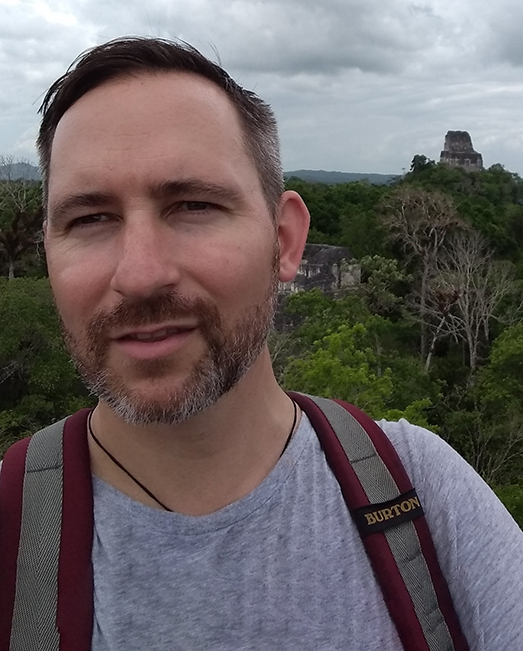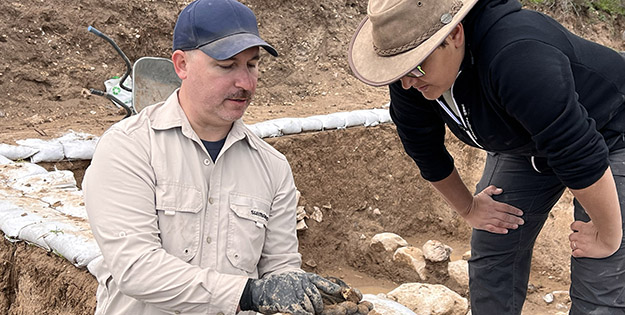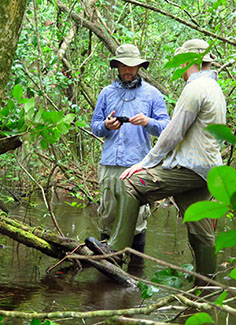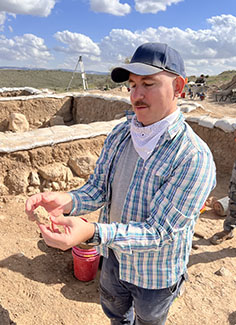Global
Copyright@ Australian Catholic University 1998-2026 | ABN 15 050 192 660 CRICOS registered provider: 00004G | PRV12008
Copyright@ Australian Catholic University 1998-2026 | ABN 15 050 192 660 CRICOS registered provider: 00004G | PRV12008

Making his way through a remote jungle in Central America, ACU’s Associate Professor Duncan Cook stumbled upon what he thought was an overgrown hillock. As he climbed higher, he realised he was standing on the remains of an ancient Maya pyramid – an immense artifact of a society and culture from over a 1,000 years ago.
“It was completely unexcavated… just sitting there in the forest,” said Associate Professor Cook.
“My mind couldn't begin to comprehend that it was actually a pyramid. I started climbing it and began noticing the stone blocks just underneath the soil and vegetation.
“There were artefacts everywhere – it was incredible.”
Associate Professor Cook’s early field work in Central America with the Smithsonian Institution, in his 20s, sparked a fascination with the Pre-Columbian Maya.
His current Australian Research Council Discovery project, with colleagues at the University of Sydney and ANSTO, examines the impact of past climate change on the Maya civilisation.
“Catastrophic climate change and drought is often invoked to explain the historic collapse of large urban centres, identifying why some cities were more resilient to the impact of climate variations than others,” he said.
The project took Associate Professor Cook to remote sites in northern Guatemala.
“It’s a landscape that is barely known to us today, it’s literally not on maps,” said Associate Professor Cook.
“Part of our project was using a technology called Lidar to map out that region, using computer assisted techniques to locate where caves might be located. Having done that, we would have to navigate the forests by GPS alone, cutting new access trails through the jungle because there's no roads or paths.
“We’d try to find where these caves were to see if there was evidence of past human activity and find the samples needed to study past climate change.
“I always find it amazing that in the world in which we live today, there's still a lot of incredibly remote locations, places that we don't know much about, that don't exist on many maps, and have never been explored, or studied scientifically.”
“The scale of past human creation that is still in the landscape today, often buried, is mind blowing.”
It may seem like the stuff of an Indiana Jones blockbuster, but for Associate Professor Cook, it’s all in a day’s work.
He describes himself as a humble geographer, and his career path began with a love of the great outdoors.
“As a kid, I remember spending a lot of time outdoors and going hiking and camping,” he said.
“I think that I developed an appreciation of the natural world, the environment around me from just being immersed in it.

“From that developed a kind of natural curiosity about how it all worked. Why do rivers flow exactly the way they do? Why is that hill higher than the other one?”
After graduating from the University of Sydney with Honours in Geomorphology, he was awarded the Henry Bertie and Florence Mabel Gritton Research Scholarship to undertake PhD research on human impacts on soil erosion from the Hunter Valley of NSW.
Since then, he has held postdoctoral research positions at the Smithsonian Institution, Georgetown University and the University of Glasgow, and spent four years as an environmental research scientist with the Defence Technology Agency of the New Zealand Defence Force.
Associate Professor Cook’s research expertise includes environmental geochemistry, palaeoenvironmental reconstruction, geochronology and geoarchaeology, with a focus on the Global Tropics and Central America.
“The historical origins of present-day environmental problems are an important part of my research,” he said.
“Most of my research is focused on understanding the impact of societies on the physical environment during the last several thousand years.
“My work argues that humans have been extracting natural resources from our planet for thousands and thousands of years. This has led to permanent impacts on the landscape, and our environments have been human modified.”
A recent research project in Cambodia featured in a National Geographic IMAX 3D film, Angkor: The Lost Empire of Cambodia.
At the height of its power between the 9th and 15th centuries, Angkor was considered the most extensive urban complex of the pre-industrial world. But by the late 16th century, this capital of the Khmer empire was largely abandoned and being overrun by the surrounding jungles. The people of Angkor left very few clues explaining why their mega-city was abandoned.
Associate Professor Cook and colleagues from Australian and European laboratories reconstructed a new climate record that spans the rise and fall of the medieval Khmer kingdom, using mineral deposits that accumulate in caves to reconstruct the medieval climate.
His research showed the rise of the Khmer Empire was linked to a hospitable climate and that the decline of the Empire coincided with prolonged drought conditions in the 14th – 16th century CE.
Associate Professor Cook’s research on the ancient Maya and their use of mercury also recently hit the headlines around the globe, featuring on the BBC, CBC, National Geographic and beyond. He pulled together data collected by archaeologists over the past century and paired them with exciting new research by environmental scientists.
The research showed that Maya people across Mexico and Central America had a history of mercury use that began at least two millennia before the arrival of the Spanish Conquistadors – and that this mercury can still be detected many centuries later in the environment today.


His team has found that ancient Maya sites across Guatemala, Belize, the Yucatan of Mexico, El Salvador, and Honduras have some instances of environmental mercury concentrations that equal or exceed modern benchmarks for toxicity.
"Archaeology has shown us that Maya were using mercury materials, but we're not getting any closer to understanding where the Maya got mercury from or how they produced liquid mercury," Associate Professor Cook said.
"The way forward is combining what we see in the archaeological record with scientific measurements of legacy mercury to get a much richer understanding of how, where and when the Maya were using mercury based on what is still in the environment today. We’re working with archaeologists and using what we find in the present to better understand the past.
"When it comes to the Maya, much of what we think we know of their history is being rapidly rewritten in the 21st century."
Associate Professor Cook said his work was a mix of field work and meticulous trial and error in the lab.
“For people who don't just like being in a laboratory all the time or for people, who like doing hands-on based research, it’s the perfect field.
“You're constantly excited about the possibilities of your research and what your research is uncovering.
“It’s a never-ending cycle of research, field work and writing – which is perpetually exciting and always exhausting. It takes up all of your time and your life, but you love it.”
He is also a passionate teacher, helping nurture the next generation. He lectures in geography, environment and society, and archaeology at ACU. That passion has been recognised with a raft of faculty, university and national teaching awards in recent years.
“The real pleasure is to communicate these findings and how it changes our understanding of environments and landscape and even human history to our students,” he said.
“You get to see them enthused. You see their eyes light up and then even in some cases, some of those students want to go on and maybe do research in your area as well. And so, the cycle continues.”
Interested in a career in archaeology? Explore the courses available at ACU.
Copyright@ Australian Catholic University 1998-2026 | ABN 15 050 192 660 CRICOS registered provider: 00004G | PRV12008